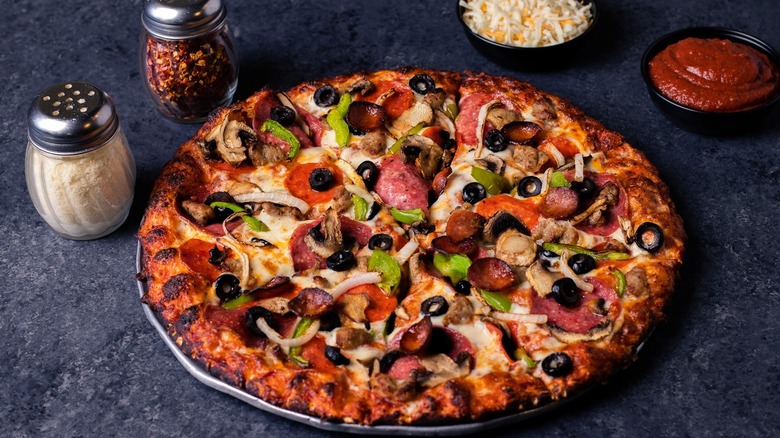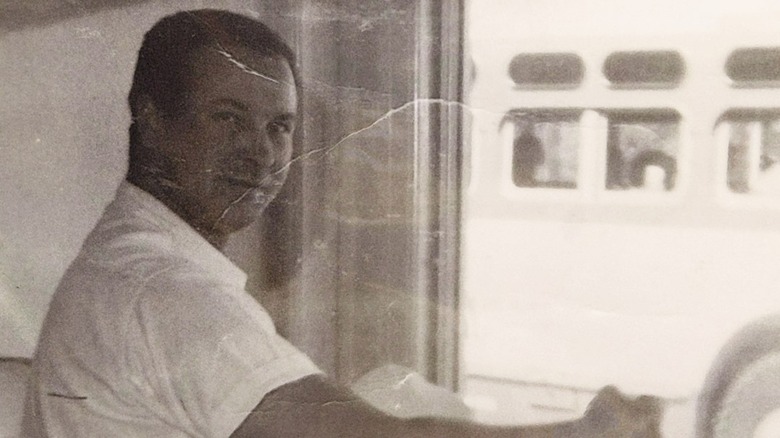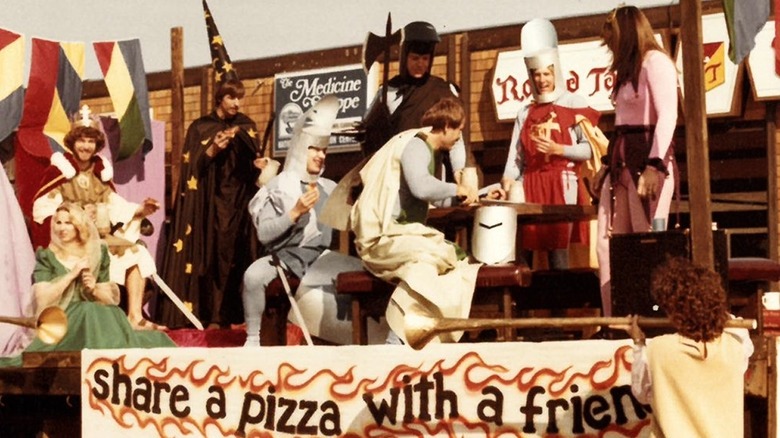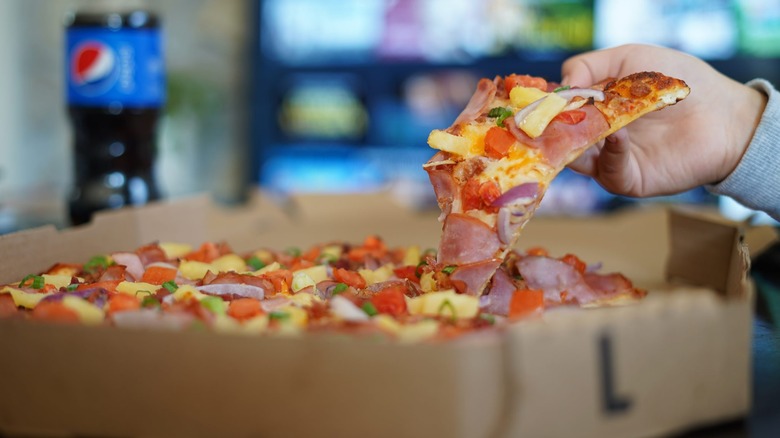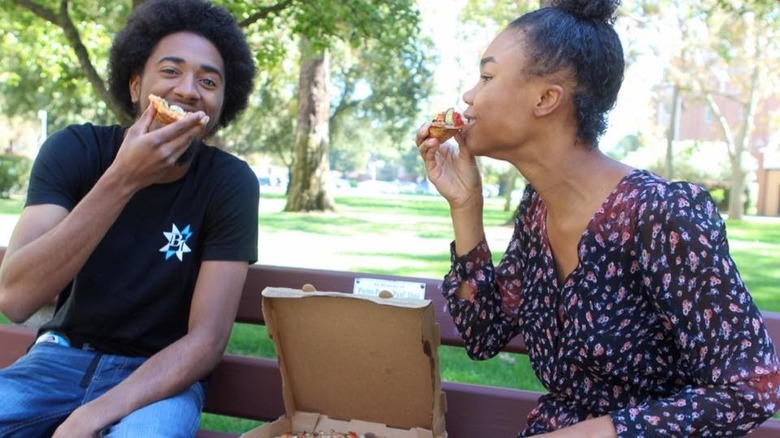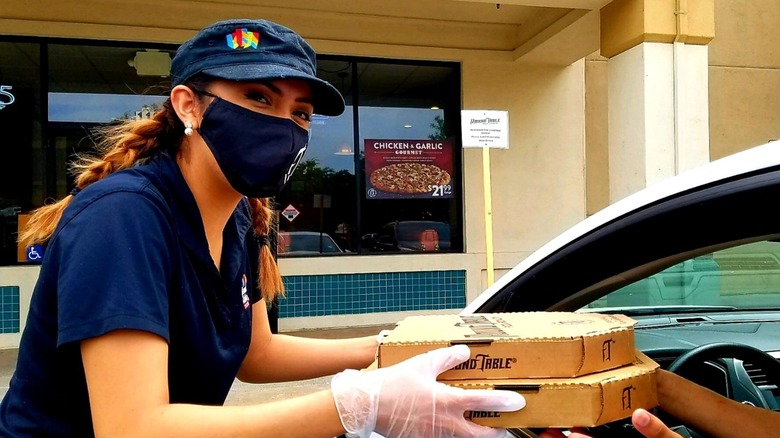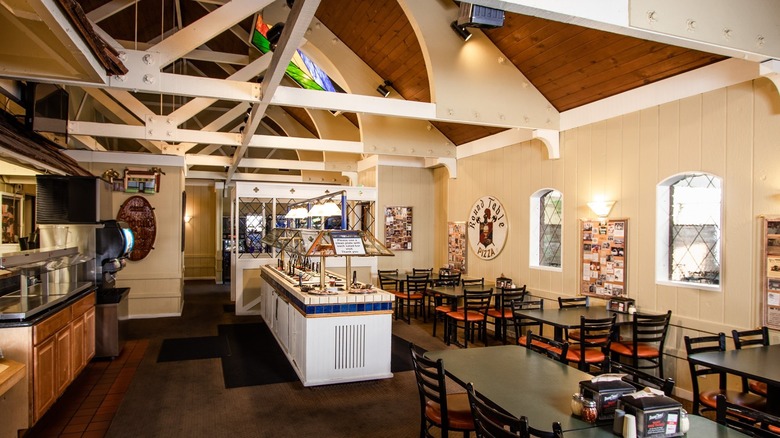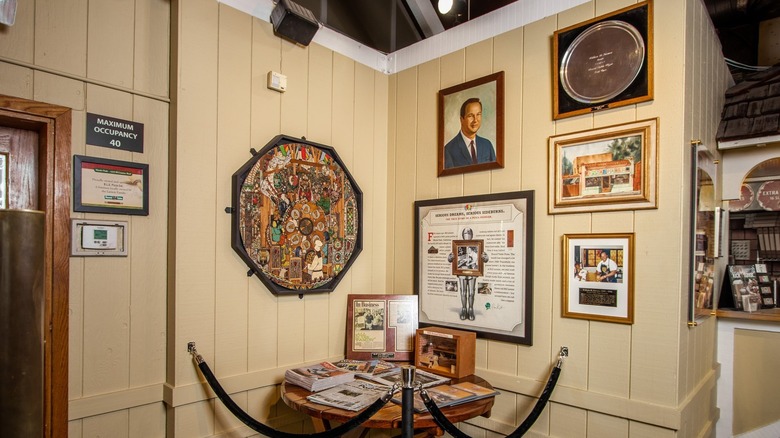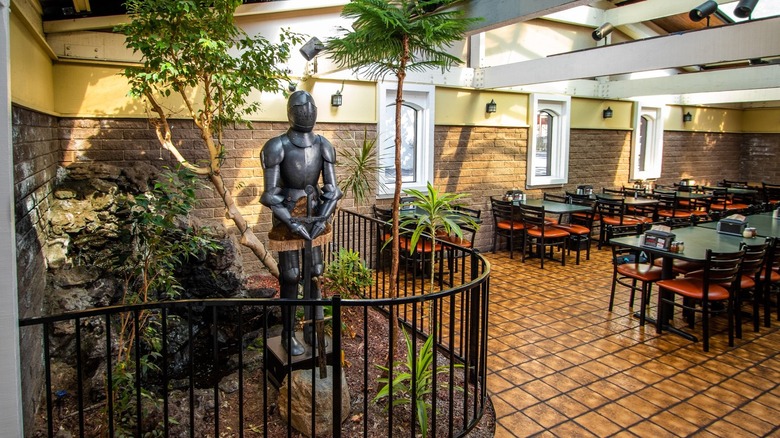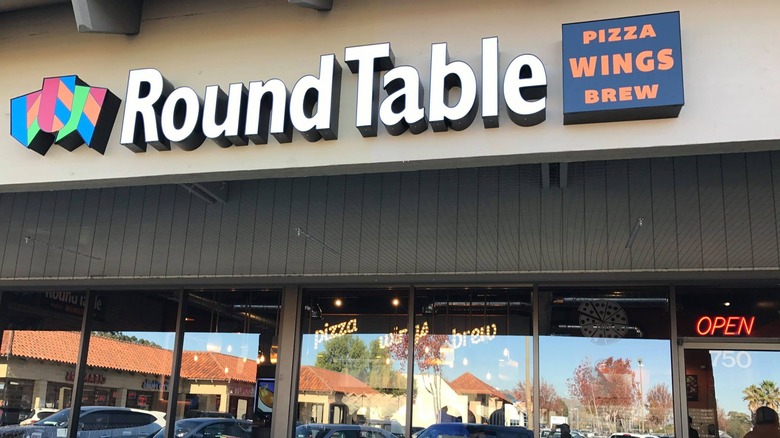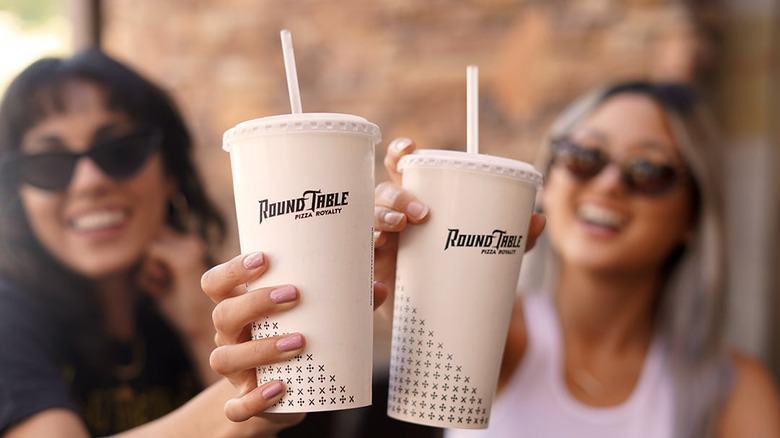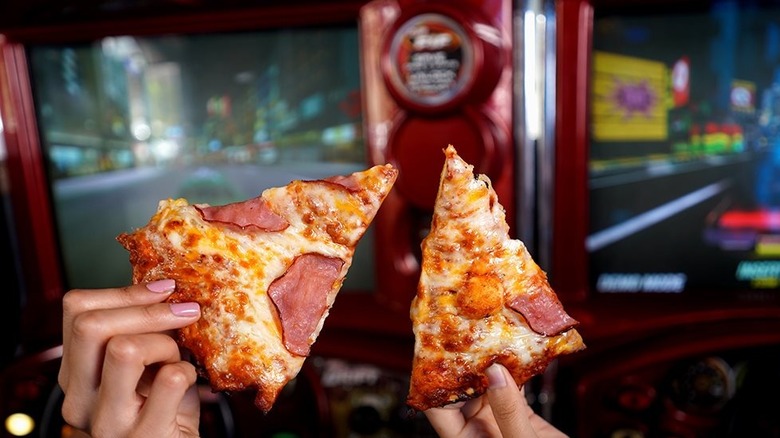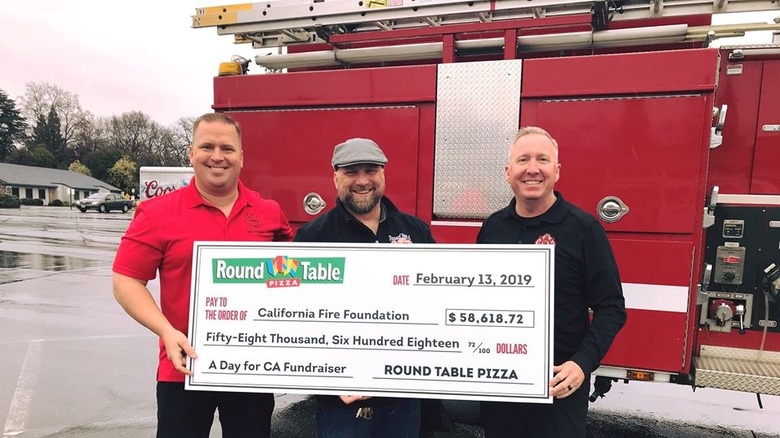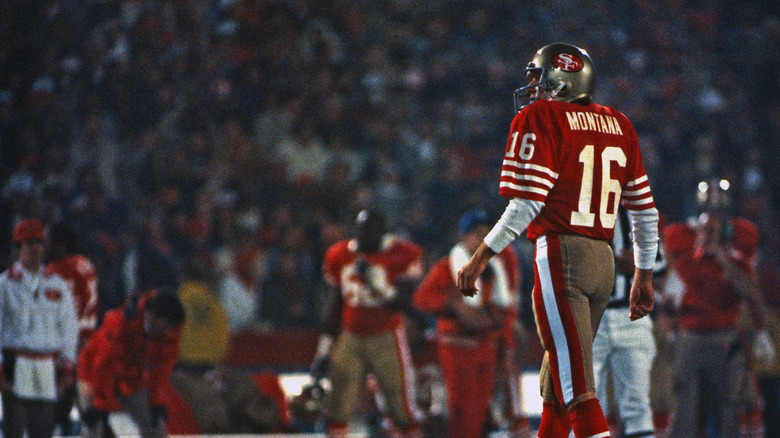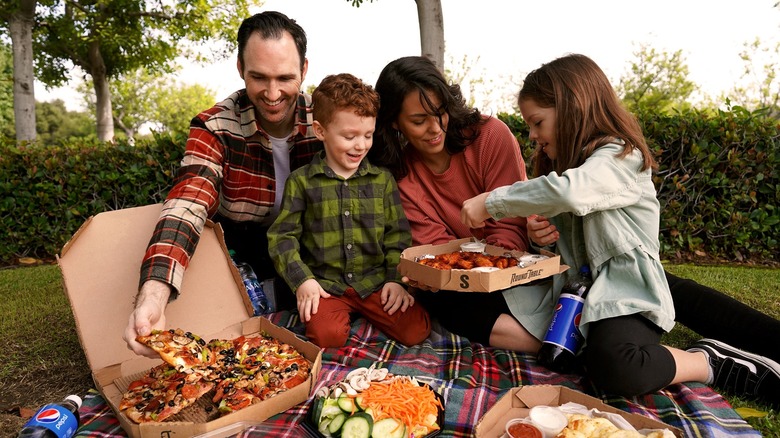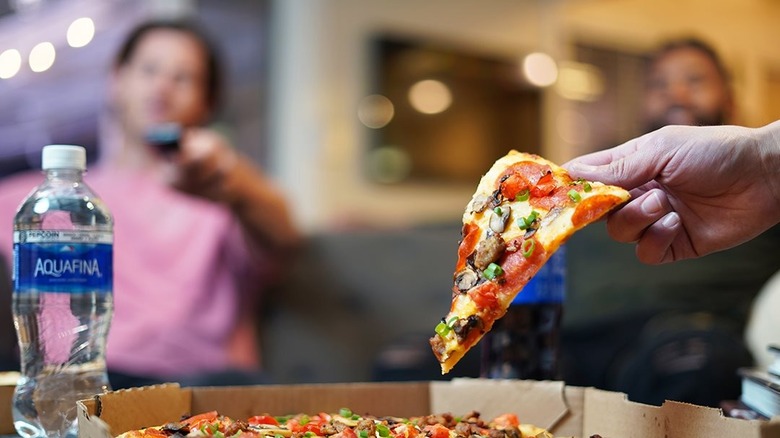The Untold Truth Of Round Table Pizza
Anyone who grew up on the West Coast is likely familiar with Round Table Pizza. The pizzeria founded by California native Bill Larson in 1959 grew from a single storefront in the Bay Area to an empire conquering the western United States. Between the freshly-baked pizzas piled high with toppings and sprawling arcade, the medieval-themed eatery defined American dining for families in the 1980s and beyond. No one who's celebrated a birthday or little league victory would forget the excitement of a freshly-baked pizza being brought to the table. Now 62 years later, it's 400+ locations strong, producing pizzas across Oregon, Washington, Idaho, Nevada, Alaska, Utah, and Hawaii (via Encyclopedia).
Part of Round Table's rise, besides the delicious pies, can be credited to the pizza patriarch's vision of a place where pizza could bring people together. The name, the recipes, the spirit can be attributed to the 'Palo Alto-born pizza king,' and the resulting success that's accrued along the way. But every chain has its story, and to understand the reign of this pizza giant, we'll need to take its history apart, slice by slice. Here's the untold truth of Round Table and how it earned its spot on the throne as "The Last Honest Pizza."
The first Round Table Pizza cost $2,500 to open
The legend of Round Table starts with the founder, Bill Larson. A former Navy veteran who drifted between odd jobs, it was a brief stint at a San Mateo pizza joint that inspired him to start his very own business. To get the venture up and running, he sought out a loan of $2,500. But in order to pay back the funds, a little more than dough was required. In a profile from the San Francisco Examiner, the young upstart claims he used his parents' furniture as collateral to lay down the loan, having no idea their son had used their possessions to make the deal (via SFGate).
While certainly not an ideal scenario, the act paid off because in 1959 the first Round Table Pizza opened for business and garnered a dedicated following of fans who wanted to get in on the pizza business. By the early 1970s, he'd amassed a number of shops before later selling stock to investors impressed by his ingenuity. Not bad for someone with under a year of pizza-making expertise!
The Round Table Pizza name doesn't come from King Arthur
Menu names like King Arthur's Supreme or Guinevere's Garden Delight conjure images of medieval castles or knights in shining armor. Yet the origins of Round Table's name are far less magisterial. The name actually references the furniture Larson's grandfather built for the restaurant when it opened in the late '50s. Consisting of square tables and a single round redwood table, the humble furnishings were meant to encourage a communal approach to dining out (via Pizza Hall of Fame). This factored into Larson's vision for the restaurant as a meeting place and early banners encouraged diners to share the pizza with friends and family.
"My dad had all square tables, which my grandfather constructed, plus one round redwood table," Bob Larson, Bill's son, told Pizza Hall of Fame. "Since pizza is a sharing food that you sit around as a group, he connected the round pizza with the round table and called it Round Table Pizza."
The King Arthur theme didn't come until 1961, when one of Larson's pals sketched a cartoon showing the knights of the round table chowing down on pizza (via InMenlo). From there, the restaurant adopted medieval imagery across the chain's marketing materials, from the menu to the logo's Coat of Arms design.
Only the freshest ingredients are used at Round Table Pizza
Compared to chains like Little Caesar's or Papa Murphy's, a pie from Round Table is definitely more expensive. Part of the higher price point, however, can be traced to the high-quality ingredients that go into each pie. Toppings are delivered fresh and prepared each day by employees, whether it be chopping produce or grating the cheese (via Orange County Register). For the cheese, the brand uses a trio of whole-milk mozzarella, provolone, and cheddar produced with microbial enzymes, a process breaking down animal proteins that's friendly to dietary restrictions. Most notable is the pizza dough, which is rolled by hand with employees sometimes rolling dough for nine hours. To Bob Larson, this is a point of pride for the establishment. "No other pizza chain has that, not Pizza Hut, not Domino's. These are craftsmen. This is why we're more expensive. I truly believe it makes a big difference in the pizza, and my customers agree" (via Round Table's website).
Customers continue enjoying the fruits of Larson's labor, as his original recipes for the dough and red sauce are still used today. Plus, its signature move of loading on the toppings to the crust would kick off the trend of gourmet pizza as we know it. By that margin, Round Table was certainly ahead of its time.
Round Table Pizza reigns supreme in California
It's clear if you live on the West Coast, a Round Table restaurant is always within close reach. But when it comes to the ubiquity of the pizza joint, one state takes the crown. ScrapeHero found that out of the country's 411 restaurants, over 300 of them reside in the state of California alone. That's 83% of the total lineup currently doing business today, including franchises and company-owned establishments.
But California is a big state, and some areas seem to feature them more prominently than others. In a list of the top 10 cities to feature Round Table, Northern California won by a landslide with San Jose, Sacramento, and San Diego holding the top three spots with 16, 14, and 7 restaurants respectively (via ScrapeHero). The only places outside California were Reno, Nevada, and Portland, Oregon with 5 locations each. While the brand continues to broaden its horizons overseas — they've expanded across five countries, including Vietnam — there's no doubt the pizzeria's home will always be in the Golden State.
Round Table Pizza was once employee-owned
In the age of massive conglomerate buyouts, employee ownership seems practically unheard of in the restaurant industry. But Round Table stands out as a tasty exception to the rule. Before the pizzeria was swallowed up by hungry corporate firms in the new millennium they were once an employee-owned operation.
Larson had sold a chunk of the company stock to investors back in the late-1970s, and those same investors took their earnings into the next decade to give employees a piece of the pie. They eventually introduced the Employee Stock Ownership Plan, a common practice allowing workers control through company stock that's transferred into interest over time. In the case of Round Table, interest would be directly funneled into retirement accounts for participating employees, who would have to complete 1,000 hours of work or retain a year of employment to qualify for the program (via Pizza Today). By the year 1992, employees had achieved total ownership. In fact, up until their eventual acquisition by major conglomerates (Global Franchise Group in 2017, FAT Brands in 2021), they were one of the largest employee-owned chains in the country.
Franchising a Round Table Pizza location is expensive
Much like their famed gourmet pies, running a Round Table of your own is a costly venture. To franchise one of its pizza shops requires a lot of dough up front. According to its website, prospective owners will need to have a net worth of $500,000 (yes, half a million) and $200,000 in liquid assets to even be considered during the application process (via Entrepreneur). Additionally, you'll need to pay a $25,000 flat fee along with the initial investment costs covering supplies, equipment, and the restaurant space itself. Did we mention the $25,000 flat fee to even franchise in the first place? It's a far cry from the modest loan Bill Larson took out, but it's also not surprising. Those pizza ovens have to come from somewhere, you know.
There are three different restaurant formats aspiring franchisees can choose from: Delivery/Carryout Only, Traditional Dine-In, and Clubhouse. Delivery/Carryout is the cheapest investment, but even then it's still $327,800 at a minimum and remains a less profitable venture than the latter two. On the plus side, Round Table offers hands-on training to those who take the gig, ensuring the franchising journey is a successful one.
The original Round Table Pizza restaurant still stands today
In this day and age, any brand whose flagship location is still standing remains an anomaly. Not so for Round table. Not only has the Menlo Park brick-and-mortar stuck around, but the business has stayed afloat into the 21st century. Referred to as "Round Table Pizza No. 1" by those in the know, the castle-like fixture on 1225 El Camino Real continues slinging pies and salads to this day. Should you walk through its hallowed doors (perhaps for a Maui Zaui and some Garlic Parmesan Twists), you'll find the dining room adorned with mementos of the chain's founder, as well as old menus and furnishings from around the time of the official opening. Case in point: the infamous redwood round table that spawned the name.
It's also become something of a tourist attraction, too. In a profile from the SFGate, Bob Larson reveals pizza-lovers will make the trek to Menlo Park specifically to visit the restaurant and snap photos of the building's brick exterior. It may not be a museum yet like the first McDonald's in San Bernardino, but with enough time we think the potential is there.
The owner's son keeps the family business alive
Despite its meteoric growth over the years, Round Table remains a family business. Bob Larson, one of Bill's nine children, carries the torch of his father's dream by franchising two locations, including the Menlo Park stronghold. Starting in his youth as a summer job, Larson's passion for the work eventually developed into a full-time occupation and by the late 1980s, he secured the keys to the first restaurant.
"I was the only kid who had a 9-5 job Monday through Friday," Larson recalled via Round Table's blog. "Most of us had paper routes back then, but I was pulling down great cash. Those managers didn't know what to make of me. They had me scrubbing toilets and scraping all the bubblegum from beneath the tables. They wouldn't break me; I did whatever they asked. It was a great experience."
He also maintains a presence in the restaurant reminiscent of his father, like busing tables and taking orders for the regulars who come in. Following Larson's eventual retirement and death in 2006, he's remained the only person directly involved in the pizza empire. What's a better place to be than the one where it all began?
Round Table Pizza bounced back from bankruptcy
Every big brand has its brush with financial struggle at some point in time. It's just a part of business. But during the Great Recession in the early 2010s, it seemed no one was safe. Following a $65 million loan taken out from Prudential Insurance and General Electric Capital, Round Table filed for Chapter 11 bankruptcy in early 2011. The funds, which were to be used for international expansion, came during one of the worst economic declines in modern history and resulted in the brand forfeiting millions in debts and assets. A low blow to the already plummeting profits they experienced at the time.
The solution? Renegotiating on debt. The pizza chain went through legal proceedings in Oakland and reached an agreement later that year outlining a 4-year repayment plan. As a result, they evaded disaster. None of the chain's 140+ franchisers would be affected by the decision, an outcome that stunned legal experts at the time. Round Table's attorney Scott McNutt described the case as a "unique bankruptcy," and "unusually successful" in the realm of financial reorganization (via The Mercury News). And it showed. As a result of the ruling, the pizza giant was able to keep most of its restaurants in business, with only 22 locations shuttering to make ends meet, as reported by The Almanac. It appears even the recession couldn't break the pizza brand.
Round Table Pizza got a royal makeover
Long-lasting brands need a shake-up now and then, and a company milestone couldn't be a better time. Just in time for its 60th anniversary in 2019, Round Table sought out a new image. With the help of the creative firm Sterling-Rice Group, they crafted a sleek new look befitting of its regal roots under the banner of "Pizza Royalty." For the campaign launch, they modernized employee uniforms, menus, and the interior and exteriors of pizza shops across the country. Most striking was the rebranded logo, whose design honored the King Arthur theme with an outline of a knight's helmet.
The brand's firm at the time Global Franchise Group remarked on the brand's "nostalgia" and "heart" in crafting the perfect pizzas people visit them for, saying "We wanted to make our passionate franchisees and our loyal customers proud by honoring the Brand's legacy and its rightful place as 'Pizza Royalty.'" (via Round Table's website). Family tradition might be the brand's bread and butter, but adapting to modern trends is crucial in keeping the eatery's legacy alive.
Business is booming for Round Table Pizza
It isn't just the pizza that draws customers to Round Table. In the age of the pizza arcade Round Table was king, providing a paradise where kids could play a round of pinball or Pac-Man to tide them over until dinner. The recent rebrand aimed to modernize the dining experience, and being no stranger to entertainment, the pizzeria decided to put a twist on what it does best.
In 2016, a sports-bar concept called the Clubhouse was launched to provide an all-ages hangout mecca. A twist on the fun zones of yore, the "Pizza-Pub-Play" offshoot featured elevated menus with specialty burgers and craft beer, televised sports, and a sprawling arcade space. All of this, in addition to the classic pizza menu, proved a winning combo for sales. In a press release from Businesswire, they found the pub-inspired format raked in more cash than standard dine-in establishments, bringing in a solid $1.45 million compared to under one million, respectively. Which makes total sense, given its casual vibes. Some might think it's too hip, but even alongside beer-battered fries and artisanal sliders, the format appears to honor the brand's identity as a family-friendly destination, both for food and fun.
Round Table Pizza serves the community
In addition to fresh-baked pies, Round Table also serves the communities the locations feed. Franchise-owners maintain an active role in helping residents from all walks of life, from public schools and churches to youth athletic programs. In the late 1990s, the chain recognized standout franchisees who went the extra mile, with achievements ranging from sponsoring summer reading programs to purchasing sports uniforms. According to Encyclopedia, franchise-owners raised $2 million for local causes in 1998 alone. Pizzerias make an ideal venue for fundraisers — they're spacious, family-friendly, and welcoming to just about any group you can think of. Plus, who doesn't like pizza?
Should you host a fundraiser at your neighborhood restaurant, it's also quite easy to do. Simply contact the restaurant to book your spot and promote it on social media before the event, where you'll be sent a check with the profits raised. Round Table promises to give at least 15% back to your cause of choice. Talk about showing up!
Round Table Pizza fed the Super Bowl
A game day spread isn't complete without a freshly-baked pie from Round Table. But its involvement with one of America's favorite pastimes goes beyond the living room couch. In 1985, they baked their specialty pizzas for a much bigger crowd than the usual customer demands: the Super Bowl.
That's right. January 20, 1985 was Super Bowl XIX, a famous showdown between the San Francisco 49ers and the Miami Dolphins, who both laid claim to unbeatable quarterbacks Dan Marino of the Dolphins and Joe Montana of the 49ers. It turns out the game, which took place at Stanford Stadium, was partially fueled by their pizza. In a profile from SFGate, Bob Larson revealed 500 pies were cooked up for those in the "World of Children's Dreams" halftime show featuring the U.S. Airforce's ensemble troupe Tops in Blue. Likely the chain's biggest order at the time, they did the Bay Area proud. The game resulted in the 49ers reigning supreme with a score of 38-16, and Montana declared MVP. Was it because of the pizza? Well, probably not. But the fact that they were somewhat tied to one of the planet's biggest sporting events is no small feat, and leaves you a little extra to chew on during your next takeout order.
Round Table Pizza launched a ghost kitchen
Ghost kitchens have emerged as a cost-efficient method for eateries to stay in business. And pizza being a portable food, it made sense Round Table Pizza would take the plunge on a growing trend. In April 2021, franchisee Leticia Vasquez launched the chain's first-ever ghost kitchen in Los Angeles. The miniature spot located on West 38th Street provides carryout and delivery service and a condensed menu of the pizzeria's most popular items, including pizza and breadsticks. There's no indoor seating of any kind, letting businesses focus the bulk of the budget on the food itself as opposed to the rent and utilities a physical restaurant requires to operate. Because there are fewer overhead costs, establishments can attain efficient business by employing fewer people.
They also take less time to open. CloudKitchens, who they teamed up with on the launch, claims a ghost kitchen restaurant can launch within six weeks with only $30,000 to start. Compared to the typical restaurant, which requires a $1 million investment upfront and at least a year to open, the differences are staggering.
Round Table Pizza grew during the pandemic
The COVID-19 pandemic shook the service industry to its core, shuttering beloved restaurants across the country at record speed. Pizza restaurants, by contrast, prevailed for their quarantine-friendly services like carryout and delivery, and Round Table exceeded all expectations during the pandemic's peak. Besides breaking record profits during 2020's lockdown at $439 million (via Restaurant Business), they also emerged 23 restaurants strong. In June 2021, an announcement from the brand revealed more restaurants were incoming, with the goal of reaching 500 locations within 2 years' time (via Round Table's website). Add in the available property at its disposal, and the pizza giant's ascent to greater heights seems inevitable.
FAT Brands Chief Development Officer Chris Creek commented on the chain's ability to endure the hardships posed by the lockdown, saying that "Americans continually turned to a reliable and beloved brand to help feed their comfort food cravings," according to 1851 Franchise.
The chain hasn't announced specifics on where the new restaurants will launch, but judging by its desire to go "coast to coast," it's clear expansion is the secret ingredient to the recipe the pizza chain's perfected.
